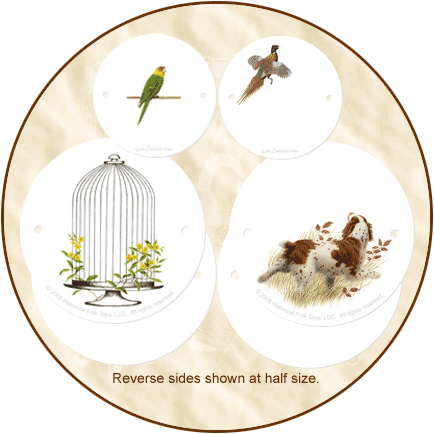.
Continued from product description on
Classic Toys & Puzzles' Page
Five...
Historical
Background: Thaumatropes are the first of many optical
instruments developed to study persistence of vision.
They typically consist of a cardboard disc with thread attached
on the left and right sides. On each side of a round piece of
card stock is a picture, painting or illustration. The images
are designed and placed so that when the disc is spun by rolling
the threads back and forth between the fingers and thumbs. The
faster the disc is spun back and forth, the more the two pictures
appear as one!
The earliest known example of a thaumatrope is a bird perched
inside a birdcage. At least it looks like a bird is perched
inside a birdcage when it is spun. On one side of the disc is
a picture of the bird sitting on a wooden perch and on the other
side of the disc is the birdcage. Again, when the disc is spun
by rolling the threads (called "handles"), these two
images appear superimposed on top of one another.
This simple optical experiment tool heralded the beginning
in the study of the persistence of vision effect. It is
also the forerunner of other experimental devices that explore
this effect, which is also known as the Phi phenomenon.
There is some disagreement over who actually made the first
contemporary thaumatrope. Some believe the "magic lantern"
was invented by either Peter Roget, Sir John Herschel, Charles
Babbage (inventor of the first computing machine), or a handful
of others. However, Dr. John Ayrton Paris is generally considered
the originator because he demonstrated the Phi phenomenon to
the Royal College of Physicians in 1824 using a thaumatrope.
Thaumatropes are not only the first toys based on persistence
of vision, they are also the simplest in design. Dr. Peter Mark
Roget learned of the persistence of vision effect and conducted
experiments to investigate after images. After images
are the result of our vision's persistency to light impressions
which "remain" in the retina cones of our eyes for
about 1/20 of a second after the initial impact of light.
Roget's discoveries led to further experimentation and the
construction of optical devices and techniques that were sometimes
referred to as "philosophical playthings." Eventually,
these devices evolved into sophisticated apparatus for mass entertainment.
Thaumatropes clearly demonstrate the delay between reality
and the visual perception of reality. For example, the
original "Bird and Cage" thaumatrope is a disc with
a perched bird on one side and a birdcage on the other. When
the disc is quickly spun by its two threads or strings, we perceive
the bird is in the cage. Of course, this is not the fact
of reality and why this thaumatrope has been called an "eye
deceiver."
The next type of "eye deceiver" is the 1833 phenakistoscope.
This device is held up in front of a mirror and rotated. For
a fraction of a second, the observer sees an image of a sequence
of image positions (such as a horse jumping a pasture fence)
through the vertical slits in the disc. The phenakistoscope is
the first known device to demonstrate perceived motion.
Another version of the phenakistoscope had two discs, one
with slits and the other with a sequence of images. While slightly
more unwieldy than the 1833 invention, it did not require the
use of a mirror. This type of phenakistoscope is thought to have
been invented simultaneously by Joseph Plateau in Belgium and
Simon von Stampfer in Austria. Regardless of who invented the
phenakistoscope, it led to the discovery of the zoetrope.
The zoetrope is a device that produces an illusion of action
from a rapid succession of static images. The name comes from
combining of two Greek words: zoe ("life") and
trope ("turn"). Its meaning has been interpreted
to be either "wheel of life" or "living wheel."
The zoetrope consists of a cylinder with vertical slits. Below
these slits on an inner surface (a disc attached to the bottom
of the cylinder) is a circular band of frames depicting a sequence
of drawings, paintings or photographs. When a user spins the
cylinder and looks down through the passing slits onto the sequence
of images, he sees animation. Viewing the images through
a slits prevents blurring and the solid areas between the slits
(along with the persistence of vision effect) create an illusion
of motion. To add more wonderment to this device, zoetropes
have the property to make images appear thinner than their actual
size when viewed "moving" through the slits!
Back to thaumatropes... During the Victorian period, thaumatropes
were a popular toy. Yet, children and adults alike were fascinated
by the Aha effect of these "wonder turners."
Thaumatrope sets were published with a variety of subjects and
themes. "Turning pair" examples included updated renditions
of "Bird and Cage," hunting scenes, horse and rider
(galloping, fence jumping, etc.), bare tree and leaves, many
styles of vases and varieties of flowers, the list goes on and
on. (Suffice to say, any picture or drawing that can be separated
into two parts.) Even today, the possibilities have not been
exhausted and that is why we include blanks in our Thaumatropes
(2016) so one can experiment and play with their own thaumatropic
designs.
Unlike our wooden Buzz Saw (2001) which is spun by winding
its strings tightly and then alternately pulling the handles
apart and immediately relaxing the tension on the strings to
make the buzz saw make a whirling or buzzing sound, a paperboard
thaumatrope uses a different technique to spin a disc.
The handles on thaumatropes are rolled back and forth between
the fingers and thumbs. One could also wind up a thaumatrope
like a buzz saw and tug away on the strings, but a handle would
eventually tear out of its paperboard hole. Not good! The fingers-thumbs
roll technique is historically correct and appropriate for it
construction material.
As popular as thaumatropes became during Queen Victoria's
reign, they did not imply motion. Thaumatropes could only take
two images and optically merge them, essentially creating
a single image -- much like a single frame in a movie film. The
phenakistoscope, on the other hand, was a great improvement on
the thaumatrope by merging stop-animation images to create
the illusion of motion. This discovery eventually led
to the development of the kinetoscope by Thomas Edison
and, in time, the birth of the movie industry. Looking back to
its earliest roots, one could say that today's movies (with all
their 2D and 3D special effects) started with thaumatropes.
How to Make a Thaumatrope
The materials you will need to make a thaumatrope are two
square or round cards with at least one blank side (such as a
couple of index cards) and two pieces of 10-inch long string.
The tools you will need are a single-hole punch; a pair of scissors,
and some drawing tools (whatever you care to use -- paint set,
felt-tipped pens, crayons, colored pencils, etc.).
Step One. Cut the two cards to the precisely
same size and shape. The shape can be square, circular (like
the original thaumatrope), or polygonal (many sided). Just make
sure both cards are the same size and shape when placed together,
back to back. Depending on the shape(s) you choose, you
may be able to cut both cards at once! Just be careful to not
let the cards move or shift while cutting them. (Speaking of
"careful," adult supervision is highly recommended
for young children using sharp objects.) This step may take some
practice to learn what works best for your card or board stock
(including cutting tool). Be patient and experiment around carefully
until you can get two pieces to look like one when placed together,
back to back. [Tip: To make circular discs, use a round cup or
glass to lightly draw a pencil circle for a cutting guide. When
done cutting, erase any pencil marks along the disc's edge.]
Step Two. Punch two holes in the cards. If you
are using square-shaped cards, punch two holes in the opposing
corners while the cards are matched together, back to
back. If you are using circular cards, just punch two holes anywhere
opposite to each other. [Tip: Punch your holes far enough inside
from the edge(s) of the card to prevent a handle from tearing
out.]
Step Three. Now comes the fun step, the creatively
fun part! On a blank piece of paper, design or sketch a picture
that can later be separated into two parts (such as a vase and
a flower). This picture can be anything you want it to be! Once
you have something you think will work well on your thaumatrope,
try another idea. Do this as often as you like. Step Three is
as fun as it gets when you try to design your own, unique thaumatrope.
Step Four. Choose a design. You may think you
want to use your best design (and this is fine if you
do), but it might be wise to make your first "wonder
turner" using one of your simpler designs. Why? Because
getting two pictures onto two different cards is a little tricky
-- especially when one of the pictures has to be upside down!
Step Five. Take one card and place it so that
the two holes are level on the left and right sides. Using a
pencil, lightly draw, sketch or trace the first part of your
two-part design. Once this is done to your satisfaction, get
the other card and put it on top of the first one so that the
punched holes match. Now, carefully turn the top card around
exactly 180 degrees (this probably will cause the holes
to not match up -- this is okay). Again, take your pencil and
lightly draw, sketch or trace the second part of your two-part
design. Make sure this second picture sits over the first card's
design. (If you cannot see your design on the first card, get
some light behind the cards -- easily done using a backlit window.)
Step Six. When you have both cards penciled
to your satisfaction (and, by the way, you can always go back
and forth penciling both cards); do a trial run before you paint
or ink in your designs. To do this, match up the holes, add some
handles, and take your cards for a spin! To make a handle, take
a piece of string and fold it in half. Thread the folded end
through one set of holes until you have enough length to take
the loose ends of the string and thread them through the folded
end, pulling it taunt to make a half-hitch knot securely against
the cards. Tie the loose ends of the string together with a knot.
Repeat this with the second string and other set of holes. You
are now ready to test your thaumatrope creation!
Step Seven. Holding the handles (string) between
your fingers and thumbs, roll the handles to spin your thaumatrope.
The faster you spin your thaumatrope back and forth, the more
it will look like one picture instead of two! How does it look
to you? If you need to make some changes, just unhitch the handles
and go back to the "drawing board" (or window pane).
Retest your design until you are "thaumatropically"
happy with your design intent.
Step Eight. Get your colored pencils, felt-tipped
pens, crayons, or whatever paints you wish to use and color in
your two pictures. Take your time! Step Eight is not the
step you want to hurry through. Sometimes, it helps to bold
some pencil lines with a black-ink pen after all the colors have
been applied.
Step Nine. The payoff! Repeat Steps Six and
Seven to see the "magic" of your new thaumatrope. Show
your friends, show your parents (or, if you're a parent, perhaps
gift it to your child), put it in an envelope with a letter and
send it to grandma and grandpa. Your payoff is as great as you
want it to be. So share your creation with others! Design more
thaumatropes and share them! People love to see "neat"
optical effects and the biggest payoff is making someone else
smile!
Ideas for Designs. Do you need some examples
that can help you think up ideas for your own thaumatropic designs?
How about: "Cool Cat" (pair of sunglasses/cat's head);
"Open Book" (open book with blank pages/words); "Ice
Water" (glass of water/floating ice cubes); "Aqua-vision"
(computer monitor/swimming fish); "One Trick Pony"
(jumping pony/large hoop); or, "Sail Boat" (boat/mast
and sail). The possibilities are practically endless in both
ideas and how to make them. Above all, try creating something
you will proud of when you are finished.
About the Artist
Our Thaumatropes (2016) were painted by William Zimmerman,
one of America's premier bird artists. His work has been, and
is today, shown in museums and galleries around the world including
the Smithsonian in Washington, D.C. Mr. Zimmerman's paintings
are published in Waterfowl of North America, The Birds
of Indiana (later proclaimed a state treasure by Governor
Robert D. Orr), The Birds of Illinois, The Birds of
Ohio, and The Birds of Kentucky. In 1987, Ducks Unlimited
Canada published Mr. Zimmerman's painting of spectacled eiders
in a portfolio that featured the works and biographies of thirty
internationally known waterfowl artists. His painting, "Ruckus
at River Styx," was one of the top 100 paintings selected
for the U.S. National Parks Foundation Arts for the Park Exhibition
that toured the United States in 1989.
We Elves will be forever grateful to Mr. Zimmerman for taking
an interest in our thaumatrope proposal and agreeing to work
with us on this project. Nor can we adequately express our thanks
for the extraordinary effort he put forth to create a pair of
unique, "philosophical playthings." We hope you will
enjoy his artistic renditions of the classic "Bird and Cage"
and traditional "Bird and Dog" thaumatropes.
Fun
Fact: The earliest zoetrope was created in China around
180 AD by the prolific inventor Ting Huan and used rising heat
from an open flame to turn it.
Fun
Fact: The modern zoetrope was invented in 1833 by British
mathematician William George Horner. He called it the "Daedalum"
or "wheel of the devil." It didn't become popular until
the 1860s when it was patented by makers in both America and
England. The American developer, William F. Lincoln, named it
"Zoetrope," which means "wheel of life."
Fun
Fact: In the Tim Burton film Sleepy Hollow, the thaumatrope
is on a necklace which Johnny Depp's character Ichabod Crane
carries with him.
Fun
Fact: In the film The Prestige, Michael Cain's character
repeatedly uses a thaumatrope as a way of explaining persistence
of vision.
Fun
Fact: Louis XIV's music video for "Guilt by Association"
was inspired by the thaumatrope. The video is edited in such
a way that even if one band member is on the screen, the others
can be seen by persistence of vision.
Not-so-fun
Fact: The bird William Zimmerman chose for his "Bird
and Cage" thaumatrope is the now-extinct Carolina parakeet.
The Carolina parakeet that died in 1918 in the Cincinnati Zoo
is frequently identified as the last living bird of this species.
The last recorded sighting of this species, however, occurred
in 1944 in North Carolina.













